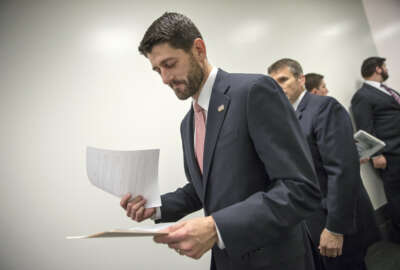
3 ways the GOP budget could change your pay and benefits
Three proposals hiding in the fiscal 2017 budget plan House Republicans submitted last week could potentially impact federal employees' pay and retirement benefits...
Federal employees might notice a few familiar proposals hiding in the fiscal 2017 budget plan House Republicans submitted last week.
Specifically, three of them could potentially impact federal employees’ pay and retirement benefits in the future.
House Republicans proposed a 10 percent cut to the overall size of the federal workforce over the next 10 years, mostly through attrition. To achieve those savings, some civilian agencies would be required to hire one new employee for every three who leave government, the resolution said.
It’s unclear just how far these proposals will go, as top-line funding levels were already set for 2017 in the Bipartisan Budget Act (BBA). And Congress has introduced all three provisions before, but most haven’t made it out of committee or haven’t cleared the Senate.
But House Republicans said cutting the size of the federal workforce, plus other civil service reforms and shared services initiatives, will free up $277.6 billion in non-defense discretionary savings over 10 years that go beyond the BBA spending caps.
1. “Reform civil service pensions”
House Republicans suggest federal employees, members of Congress and their staff make greater contributions to their defined benefit retirement plans.
Citing a proposal from the President’s National Commission on Fiscal Responsibility, the budget resolution recommends adopting defined contribution retirement plans common in the private sector.
The House Republicans’ resolution does not mention specific details. But in its 2010 report, the Commission pitched using the highest five years of an employee’s earnings to calculate civil service pensions for new retirees.
2. Interest rate cuts to the Thrift Savings Plan’s G-Fund
The budget proposal mentions few details, but the idea of changing the way the Federal Retirement Thrift Investment Board calculates the average interest rate for the G-Fund in the Thrift Savings Plan is back on the table.
“The resolution assumes savings by correctly aligning the rate of return on U.S. Treasury securities within the Federal Employee Retirement System’s Thrift Savings Plan with its investment risk profile,” the proposal said.
The House floated this idea last year to help pay for major transportation infrastructure upgrades, but the Senate rejected that plan. At the time, House lawmakers estimated such change would earn $32 billion in savings over 10 years.
However, their 2017 budget proposal makes no mention of specific savings or a timeline for implementation.
The board said it would remind Congress of the potential impacts this could have on TSP participants, specifically an influx of 500,000-750,000 new military members who will automatically enroll in the plan by 2018.
“To the extent that there’s an impact to the G fund and that interest rate is reduced, that will have an impact on new uniformed service members,” Kim Weaver, director of external affairs at the FRTIB, said at the board’s monthly meeting March 29.
The 2016 National Defense Authorization Act, which Congress passed last November, encourages current military members — and requires new ones — to invest in the TSP.
3. End the special Social Security retirement supplement
The budget proposal calls for an end to the Social Security retirement supplement, which currently gives federal employees who retire early the ability to collect similar benefits until they’re Social Security eligible.
Under the GOP’s plan, a federal employee who chooses to retire at age 56, for example, would no longer have access to 6 years of Social Security-equivalent benefits. That retiree would have to wait until age 62 to earn access to his Social Security benefits.
“This would achieve significant savings while recognizing the need for new federal employees to transition to a defined contribution retirement system,” the budget resolution said.
The budget resolution does not include details or an estimation of what those savings might look like.
Copyright © 2024 Federal News Network. All rights reserved. This website is not intended for users located within the European Economic Area.
Nicole Ogrysko is a reporter for Federal News Network focusing on the federal workforce and federal pay and benefits.
Follow @nogryskoWFED




